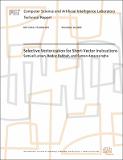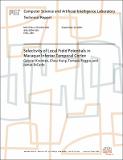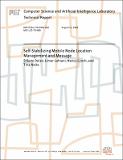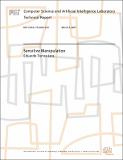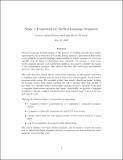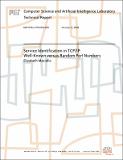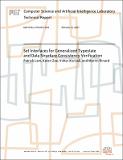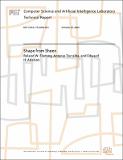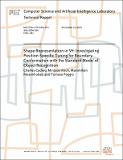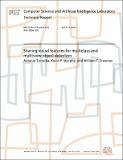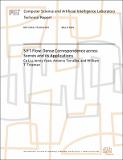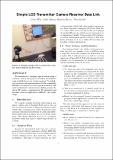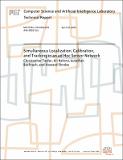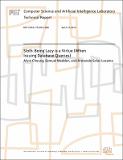Browsing CSAIL Digital Archive by Title
Now showing items 650-669 of 806
-
Selective Vectorization for Short-Vector Instructions
(2009-12-18)Multimedia extensions are nearly ubiquitous in today's general-purpose processors. These extensions consist primarily of a set of short-vector instructions that apply the same opcode to a vector of operands. Vector ... -
Selectivity of Local Field Potentials in Macaque Inferior Temporal Cortex
(2004-09-21)While single neurons in inferior temporal (IT) cortex show differential responses to distinct complex stimuli, little is known about the responses of populations of neurons in IT. We recorded single electrode data, including ... -
Self-Adaptive Systems for Information Survivability: PMOP and AWDRAT
(2007-04-10)Information systems form the backbones of the critical infrastructures of modern societies. Unfortunately, these systems are highly vulnerable to attacks that can result in enormous damage. Furthermore, traditional approaches ... -
Self-Stabilizing Message Routing in Mobile ad hoc Networks
(2009-01-28)We present a self-stabilizing algorithm for routing messages between arbitrary pairs of nodes in a mobile ad hoc network. Our algorithm assumes the availability of a reliable GPS service, which supplies mobile nodes with ... -
Self-Stabilizing Mobile Node Location Management and Message
(2005-08-11)We present simple algorithms for achieving self-stabilizing locationmanagement and routing in mobile ad-hoc networks. While mobile clients maybe susceptible to corruption and stopping failures, mobile networks areoften ... -
Sensitive Manipulation
(2007-03-02)This thesis presents an effective alternative to the traditionalapproach to robotic manipulation. In our approach, manipulation ismainly guided by tactile feedback as opposed to vision. Themotivation comes from the fact ... -
Sepia: a Framework for Natural Language Semantics
(2009-05-28)To help explore linguistic semantics in the context of computational natural language understanding, Sepia provides a realization the central theoretical idea of categorial grammar: linking words and phrases to compositional ... -
Service Identification in TCP/IP: Well-Known versus Random Port Numbers
(2006-01-11)The sixteen-bit well-known port number is often overlooked as a network identifier in Internet communications. Its purpose at the most fundamental level is only to demultiplex flows of traffic. Several unintended uses of ... -
Set Interfaces for Generalized Typestate and Data Structure Consistency Verification
(2007-10-31)Typestate systems allow the type of an object to change during its lifetime in the computation. Unlike standard type systems, they can enforce safety properties that depend on changing object states. We present a new, ... -
Shape from Sheen
(2009-10-22) -
Shape Representation in V4: Investigating Position-Specific Tuning for Boundary Conformation with the Standard Model of Object Recognition
(2004-11-12)The computational processes in the intermediate stages of the ventral pathway responsible for visual object recognition are not well understood. A recent physiological study by A. Pasupathy and C. Connor in intermediate ... -
Sharing visual features for multiclass and multiview object detection
(2004-04-14)We consider the problem of detecting a large number of different classes of objects in cluttered scenes. Traditional approaches require applying a battery of different classifiers to the image, at multiple locations and ... -
SIFT Flow: Dense Correspondence across Scenes and its Applications
(2010-05-08)While image alignment has been studied in different areas of computer vision for decades, aligning images depicting different scenes remains a challenging problem. Analogous to optical flow where an image is aligned to its ... -
Simit: A Language for Physical Simulation
(2015-05-26)Using existing programming tools, writing high-performance simulation code is labor intensive and requires sacrificing readability and portability. The alternative is to prototype simulations in a high-level language like ... -
Simple LCD Transmitter Camera Receiver Data Link
(2009-06-15)We demonstrate a freespace optical system using a consumer camera and projector in indoor environments using available devices for visual computing. Through design, prototype and experimentation with this commodity hardware, ... -
Simulation of Human Motion Data using Short-Horizon Model-Predictive Control
(2008-01-15)Many data-driven animation techniques are capable of producing high quality motions of human characters. Few techniques, however, are capable of generating motions that are consistent with physically simulated environments. ... -
Simultaneous Localization and Tracking in Wireless Ad-hoc Sensor Networks
(2005-05-31)In this thesis we present LaSLAT, a sensor network algorithm thatsimultaneously localizes sensors, calibrates sensing hardware, andtracks unconstrained moving targets using only range measurementsbetween the sensors and ... -
Simultaneous Localization, Calibration, and Tracking in an ad Hoc Sensor Network
(2005-04-26)We introduce Simultaneous Localization and Tracking (SLAT), the problem of tracking a target in a sensor network while simultaneously localizing and calibrating the nodes of the network. Our proposed solution, LaSLAT, ... -
Slicing the Onion: Anonymous Routing Without PKI
(2005-08-15)Recent years have witnessed many proposals for anonymous routing in overlay peer-to-peer networks. The proposed protocols either expose the receiver and the message content, or require the overlay nodes to have public-private ... -
Sloth: Being Lazy is a Virtue (When Issuing Database Queries)
(2014-04-14)Many web applications store persistent data in databases. During execution, such applications spend a significant amount of time communicating with the database for retrieval and storing of persistent data over the network. ...
